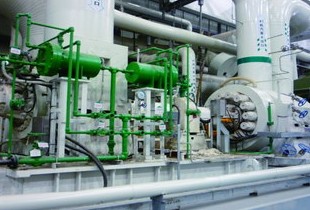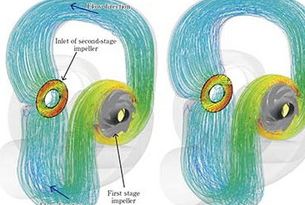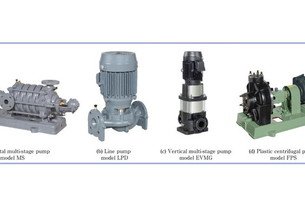Issue No. 253〔[Delivered Products & Systems〕
Improvement Work for “Kameda Waste Management Center”
Author
Takashi IMAIZUMI*
Hideo YAMASHITA*
Shunsuke NOMURA*
- *
Ebara Environmental Plant Co., Ltd.
The improvement work of “Kameda Waste Management Center” in Niigata City was completed in March 2016. This work was successfully completed through the ensuring of safe vehicle traffic lines and a carefully elaborated work plan, despite the fact that it had to be carried out under the restrictions of continuation of regular waste disposal operations and a short work period of four months per incinerator. In the performance tests of each incinerator conducted at the end of the work, it was confirmed that the incinerator was able to realize stable operation with a low air ratio of 1.3 and reduced NOx and CO while meeting all reference values. In addition, the amount of CO2 emitted by the center was reduced by 46.3% compared to before the improvement work.
Keywords: Improvement work, Fluidized-bed, Waste incinerator, Low excess air ratio combustion, Combustion control, Slow combustion, Exhaust gas recirculation, Carbon monoxide, Nitrogen oxides
1. Introduction
Ebara Environmental Plant Co., Ltd. undertook the improvement work of the Kameda Waste Management Center (Figure 1) from July 2012 to March 2016. This waste treatment facility was constructed by Ebara in 1997 and outfitted with power generation equipment and recycling equipment, and we conducted the improvement work to improve and extend the life of superannuated equipment that had been in operation for 15 years from the completion of the construction work.The center consists of a fluidized-bed incineration facility with a treatment capacity of 390 t/d (130 t/d× three incinerators), a noncombustible facility with a treatment capacity of 50 t/d, and power generation equipment.

Fig. 1 Kameda Waste Management Center
2. Overview of the Improvement Work
The improvement work was intended to renew superannuated equipment and improve their functions. Figure 2, Figure 3, and Table 1 show the entire center, a flow sheet of the incineration treatment facility after the improvement work, and the specifications of the main equipment and the details of the main operations of the improvement work, respectively.
To reduce CO2 emissions of more than 20 %, the improvement work was conducted for the purposes of (1) changing a steam turbine to an extraction turbine, (2) increasing the amount of electricity generated and reducing the power consumption by reducing the air ratio through combustion stabilization, and (3) reducing the CO peak through combustion stabilization.
The details of the improvement effect by the improvement work are reported in “Performance of Fluidized-bed Incineration Facilities and their Potential” included in this issue of Ebara Engineering Review, and this paper presents an overview of the improvement work.

Fig. 2 Aerial view of the center

Fig. 3 Flow sheet of incineration facility after improvement work
| Receiving/supply equipment | Specification change | |
| Waste weighing scale | Weighing capacity 30 t (IC card type)×4 units | Weighing scale added |
| Waste crane | Fully automatic fork type grab bucket×2 units | Energy-saving bucket adopted |
| Combustion equipment | ||
| Waste feeder | 4-axis screw conveyor×3 units | Performance of scraper enhanced |
| Inverter system | ||
| Incinerator | Full continuous combustion type fluidized-bed incinerator (TIF incinerator) | Modified in connection with slow combustion, low excess air ratio operation, and exhaust gas recirculation |
| Treatment capacity: 390 t/d (130 t/d×3 units) | ||
| incombustible unloader | 2-axis screw conveyor with jacket×3 units | Renewed |
| Sand classifier | Enclosed type vibrating screen×2 units | Renewed |
| Sand circulation system | Bucket elevator×3 units | Renewed in par |
| Combustion gas cooling equipment | ||
| Boiler | Water tube boiler for natural/forced circulation | Water tube renewed Economizer renewed |
| Amount of steam: 22 t/h×3 cans | ||
| Normal pressure: 2.65 MPa×290 ℃ | ||
| Flue gas cooler | Water injection type | Renewed in part |
| Equipment using excess heat | ||
| Steam turbine | Multistage type extraction condensate turbine | Changed to extraction turbine |
| Generator | 3-phase AC synchronous generator: 5500 kW | Amount of electricity generated increased from 5100 kW to 5500 kW |
| Exhaust gas treatment equipment | ||
| Bag filter | Air pulse back flushing type×3 units Filter cloth type: PTFE | Filter cloth area increased Filter cloth type changed |
| Draft equipment | ||
| Forced draft fan | Turbo blower×3 units | Changed to high-efficiency type |
| Secondary forced draft fan | Turbo fan×3 units | Changed to high-efficiency type |
| Flue gas recirculation fan | Turbo fan×3 units | Newly installed |
| Induced draft fan | Turbo fan×3 units | Changed to high-efficiency type |
| Ash cleanout equipment | ||
| Kneading and forming machine | Chemical mixing and extrusion forming type×2 units | Renewed |
| Fly ash conveyor | Chain conveyor×3 units | Renewed |
| Solidified ash bunker | Capacity: 19 m3 ×4 units | Renewed |
2.1 Change of the turbine
The steam turbine was changed to an extraction turbine to increase the rated output of the generator from 5100 kW to 5500 kW. Previously, high-pressure steam had been depressurized and used for low-pressure steam for equipment using excess heat, but it was changed to turbine extraction steam.This change increased the amount of steam contributing to power generation and the amount of electricity generated. When changing the turbine, a large opening was made in the south-side wall of the turbine room, through which the steam turbine and the generator were carried in (Figure 4 and Figure 5). In addition, since the steam turbine was larger than the existing turbine, we modified the turbine foundation to support the increased weight.

Fig. 4 Carrying in a steam turbine

Fig. 5 Renewed steam turbine generator
2.2 Combustion stabilization
We successfully stabilized combustion by improving the performance of feeding a constant amount of waste and slowing incinerator bed combustion.
Combustion can be stabilized by improving the performance of feeding a constant amount of waste. In the improvement work, this performance was improved from the conventional level by increasing the scraping frequency and the performance of the scraper of the waste feeder.
A slow combustion process was adopted to stabilize incinerator bed combustion. Slow combustion of the incinerator bed lowers the temperature therein and slows combustion within the fluidized bed by reducing the amount of fluidized air and the air-in-sand ratio. As a result, we achieved stable operation even at a lower air ratio than that before the improvement work, and directly reduced the power consumption by reducing the load on the forced draft fan.
2.3 Low excess air ratio combustion
We reduced the air ratio at the outlet of the boiler from 1.8 to 1.3 by reducing the amount of secondary combustion air. The reduction of secondary combustion air also helped prevent the production of thermal NOx, and the power consumption was successfully curtailed by reducing the load on the secondary fan and the induced draft fan.
We adopted flue gas recirculation as a new process for the improvement work.
As the amount of flue gas is reduced, the sensible heat carried out by flue gas decreases. Thus, we succeeded in increasing the calorific value recovered in the boiler and the amount of electricity generated.
We made it possible to lower the incinerator top temperature by blowing the flue gas treated by the flue gas treatment equipment back into the incinerator without pouring water into the incinerator top, which resulted in the reduction of heat loss due to pouring of water. The dilution stirring effect also controlled the production of CO.
In the process of renewing existing units for the purpose of reducing the power consumption, we adopted high-efficiency units, an inverter control system, and LEDs for lighting.
2.4 Improvement work processes
We concluded two separate contracts, one for distributed control system (DCS) renewal work and one for the improvement work itself, and conducted the DCS renewal work in February 2013 and the improvement work from June 2014 to March 2016. To continue regular waste treatment operation, the improvement work was conducted with two of the three incinerators in operation and the remaining incinerator performing work and each incinerator was handed over to the center upon the completion of its work. The main processes of the improvement work are shown in Table 2. The period of the work required per incinerator was only four months.
| Contract for DCS renewal work | July 2012 |
| DCS renewal work | February 2013 |
| Completion of DCS renewal work | March 2013 |
| Contract for improvement work | December 2013 |
| Common system work | June 2014 |
| Incinerator 1 system work | July to October 2014 |
| Preliminary performance test | November 2014 |
| Delivery performance test | December 2014 |
| Incinerator 2 system work | July to October 2015 |
| Preliminary performance test | November 2015 |
| Delivery performance test | December 2015 |
| Incinerator 3 system work | February to May 2015 |
| Preliminary performance test | May 2015 |
| Delivery performance test | June 2015 |
| Turbine-related work | July to December 2015 |
| General preliminary performance test | December 2015 |
| General delivery performance test | January 2016 |
| Completion | March 2016 |
3. Implementation of the Improvement Work
We considered the following points in order to continue regular waste treatment operation in concurrence with the improvement work:
3.1 Elaborated improvement work plan
The period of the improvement work of each incinerator system was only four months, during which we had to clean the incinerator, remove the installed units, assemble and install the renewed units, and coordinate with regular maintenance.
Thus, we divided the building into six areas, worked out an elaborated improvement work plan, controlled the operation process in each area, and completed the improvement work in the short work period by eliminating unnecessary operations, such as complicated operations and re-scaffolding, while concurrently carrying out each operation (Figure 6).

Fig. 6 Six areas inside the building
3.2 Securing vehicle traffic lines
In the improvement work, we placed only the minimum necessary number of large cranes and other heavy equipment around the building to ensure the smooth traffic of waste carry-in vehicles and residue carry-out vehicles, and installed a temporary overhead traveling crane inside the building and a large machine hatch on each floor to carry units into the building and assemble them inside.In connection with these operations, we reduced operation man-hours in the field by dividing large units, such as a bag filters and waste feeder, into blocks of maximum sizes that could be carried into the building (Figure 7).

Fig. 7 Carrying in and installing a bag filter
4. Delivery Performance Test
A performance test of the renewed facilities was conducted at the completion of the work of each incinerator, started operating the incinerators one after another, and completed all delivery performance tests in January 2016.The results of the delivery performance tests of each incinerator are shown in Table 3.
The incinerators met the judgment criteria for all test items and were able to be operated stably. The average NOx and CO concentrations, in particular, were as low as 24 ppm and 4 ppm, respectively, proving the effect of the improvement work.
We also achieved a CO2 reduction rate of 46.3 %※ from that before the improvement work, which far exceeded the requirement of 20 % of the promotion subsidy for the establishment of a sustainable society.
※Calculated according to Literature 2) below.
| Item | Unit | Judgment criterion | Results | Judgment | ||
| Incinerator 1 | Incinerator 2 | Incinerator 3 | ||||
| Incineration capacity | t/d each | Approx. 130 | 125 | 129 | 129 | Passed |
| Flue gas | ||||||
| Dust | g/m3 (NTP) | ≦0.016 | <0.001 | <0.001 | <0.001 | Passed |
| Sulfur oxides | m3(NTP) /h | ≦2.4 | 0.027 | <0.019 | <0.024 | Passed |
| Nitrogen oxides | ppm | ≦160 | 26 | 22 | 23 | Passed |
| Hydrochloric acid | g/m3 (NTP) | ≦280 | 18 | 44 | 49 | Passed |
| Carbon monoxide | ppm | ≦100 | 3 | 3 | 6 | Passed |
| DXNs | ng-TEQ/ m3(NTP) | ≦0.5 | 0.0083 | 0.004 | 0.015 | Passed |
| Incineration residue (residue under incinerator) | ||||||
| Mercury | mg/L | ≦0.005 | <0.0005 | <0.0005 | <0.0005 | Passed |
| Alkyl mercury | mg/L | Shall not be detected | Not detected | Not detected | Not detected | Passed |
| Cadmium | mg/L | ≦0.3 | <0.005 | <0.005 | <0.005 | Passed |
| Lead | mg/L | ≦0.3 | <0.01 | <0.01 | <0.01 | Passed |
| Hexavalent chromium | mg/L | ≦1.5 | <0.02 | <0.02 | <0.02 | Passed |
| Arsenic | mg/L | ≦0.3 | <0.01 | <0.01 | <0.01 | Passed |
| Selenium | mg/L | ≦0.3 | <0.01 | <0.01 | <0.01 | Passed |
| Ignitin loss | % | ≦3 | 0.3 | 0.2 | 0.3 | Passed |
| Incineration residue (treated fly ash) | ||||||
| Mercury | mg/L | ≦0.005 | <0.0005 | <0.0005 | <0.0005 | Passed |
| Alkyl mercury | mg/L | Shall not be detected | Not detected | Not detected | Not detected | Passed |
| Cadmium | mg/L | ≦0.3 | <0.005 | <0.005 | <0.005 | Passed |
| Lead | mg/L | ≦0.3 | <0.01 | <0.01 | <0.01 | Passed |
| Hexavalent chrominum | mg/L | ≦1.5 | <0.02 | 0.02 | 0.03 | Passed |
| Arsenic | mg/L | ≦0.3 | <0.01 | <0.01 | <0.01 | Passed |
| Selenium | mg/L | ≦0.3 | <0.01 | <0.01 | <0.01 | Passed |
| Ignition loss (raw ash) | % | ≦3 | 0.6 | 0.5 | 0.5 | Passed |
| CO2 reduction rate | % | ≧20 | 46.3 | Passed | ||
| Air ratio | − | − | 1.3 | 1.3 | 1.3 | − |
5. Conclusion
The improvement work of the center was completed in March 2016, and the center is operating in good condition. After the improvement work, we at Ebara Environmental Plant Co., Ltd. were also entrusted with the nighttime and holiday operation of the center. We are determined to ensure that the center operates smoothly for many years to come and to contribute to the establishment of a sustainable society.
In conclusion, we would like to express our sincere gratitude to the city of Niigata and to all those who offered a great deal of advice and cooperation to us in all stages, from the design of the center to its construction and commissioning.
References
1) Keisuke Tsukamoto, Kenichi Nishiyama, et al.: Construction of Municipal Waste Treatment Plant “Clean Plaza Yokote”, Ebara Engineering Review No. 252, pp. 69-74 (October 2016).
2) Improvement Work Manual for Waste Treatment Facilities, Waste Management Division, Waste Management and Recycling Department, Minister’s Secretariat, Ministry of the Environment, revised in March 2015.
This paper was compiled by making some additions and corrections to the paper included in the “38th Proceedings of Conference of Japan Waste Management Association Vol.38 (2017)”
Recommended articles
Inquiry about Ebara Engineering Review



